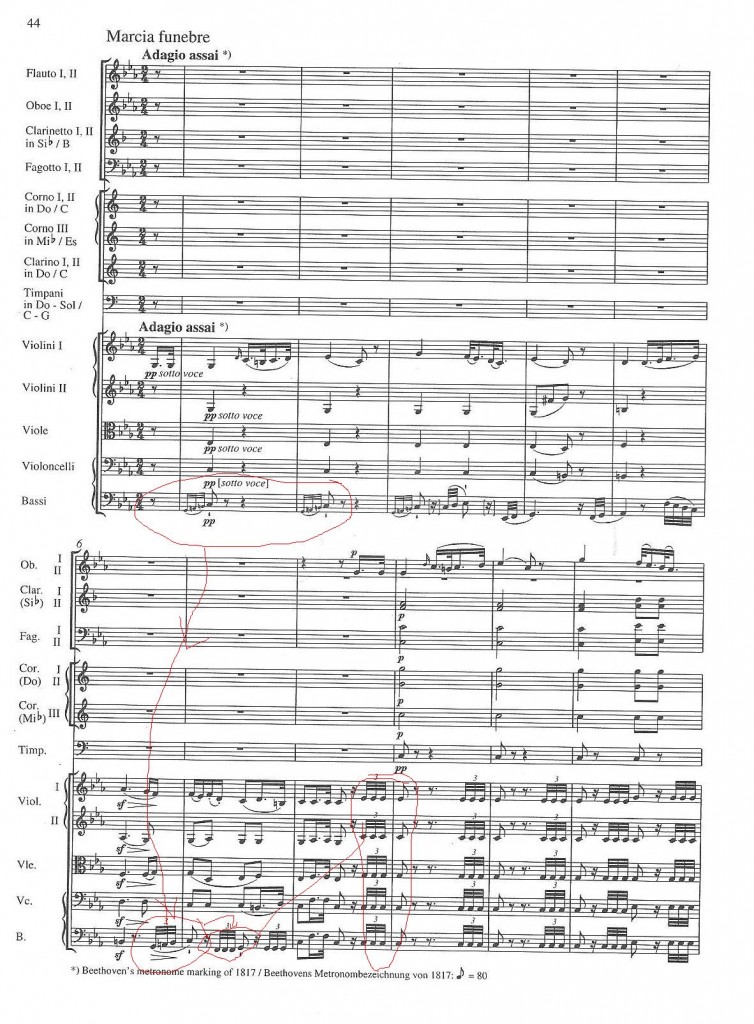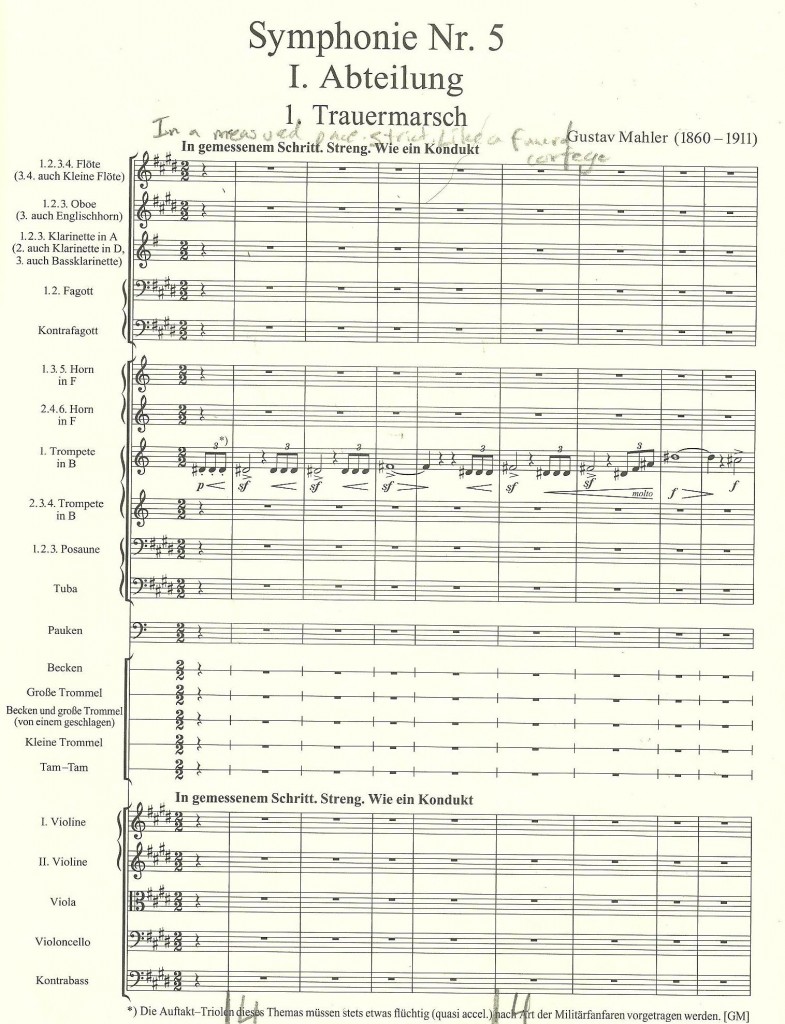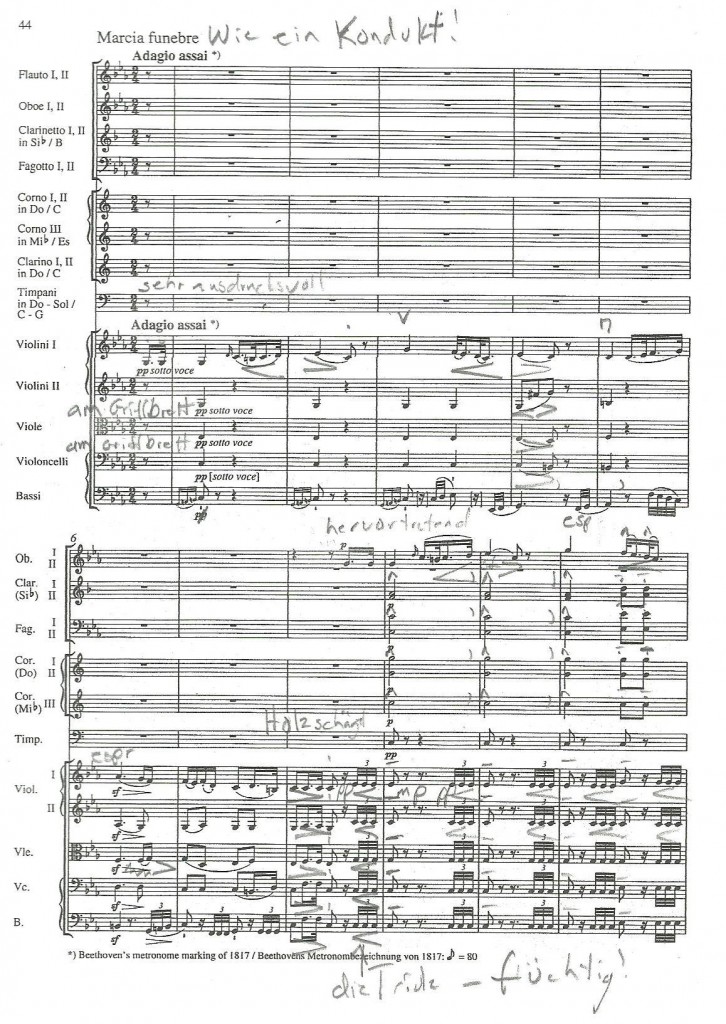In my last post on Beethoven 3, I talked just a little bit about my experience of studying the work with my teacher, Gerhard Samuel (more on him here and here). It remains a particularly memorable experience since it was the first score we went through together, so I much of what I learned about his ways of looking at a score I learned through our work on this piece.
Not all went smoothly in those sessions. Like many musicians and listeners, I struggled sometimes to understand Beethoven’s tempo indications. Gerhard’s outlook on tempi was very simple- one took the composer’s tempo, whether you understood it or not. “You don’t need to understand Beethoven- you just need to respect what he’s written.” I, on the other hand, felt, perhaps with an exaggerated sense of self-importance, that I had to understand why that tempo was right, and that I had to believe in it.
In particular, I couldn’t seem to accept what seemed like a perversely fast metronome marking of 8th=80 in the Marcia funebre. I’d grown up with some monumental performances at tempos almost half that speed by people like Furtwangler and Jochum. Of course, when I started conducting it like that, Gerhard screamed like I’d just closed his fingers in a car door and told me I was far too slow. “But it’s a funeral march! It is supposed to be slow!” I protested. I clumsily tried to demonstrate my idea of a funeral march while seated…
Whereupon, Gerhard stood up and showed me the actual march steps of a traditional Austro-German funeral march, while singing the Beethoven. Around the studio he walked- it’s a very distinct pattern of steps, and would look quite absurd at the slower tempo.
About ten years later, I conducted a performance of it here in the UK that got filmed. One of the violinists in the orchestra took the DVD with him to Germany (unbeknownst to me) to show his friend, an elderly but very distinguished critic and Beethoven scholar. My colleague gleefully reported his friend’s reaction to the slow movement.
“Jah! Dis is a verry gut tempo- ein nice balanz betveen zee strong und veek beats, und die tempo is sehr gut for zee real marcia, ven vee valk like dees..” Whereupon, the great man stood up from his couch and started marching around his study to the strains of our recording, while my friend stared on in amazement. My friend’s recreation of the great man’s march looked almost exactly the same as what Gerhard (who was, of course, raised in the same part of the world) had showed me ten years before.
That the same passage of music should inspire the same “dance steps” from two men in the know, 5000 miles and ten years apart is not really surprising. This kind of march would have been a well known civic phenomenon, which was a part of the culture for many generations. It’s no accident that the opening Trauermarche of Mahler’s 5 Symphony is all built of the same rhythmic materials (albeit notated in a different meter- in Beethoven, the eighth note is the pulse, while in Mahler, it is the half note- the tempo is almost exactly the same). There are two good reasons for this- Beethoven’s Marcia funebre was Mahler’s obvious model, and, Mahler was also looking to the same models in vernacular music as Beethoven.
In both the case of the Beethoven and the Mahler, the music’s roots in vernacular music have led the composer to try to find ways o notating something that is not easily written down- the speed of the triplet pickups. In Mahler’s case, he puts a footnote in the score suggesting that the triplets should be played “flüchtig” or faster than marked. The easiest “cheat” for this is to play the figure in 6/4 instead of 2/2- by starting the triplets on the 3rd subdivision of a beat divided in 3 rather than in the middle of the beat, you get something much closer to the military fanfare Mahler is asking for. However, Mahler also says the triplets should be played “quasi accel.” Taken literally, that would mean that that the triplet starts a bit slow and finishes a bit fast, relative to even the 6/4 subdivision. It’s an effect that is hard to describe, but easy to recognize if done correctly.
Beethoven also tried to get across the un-notatable nature of the triplet rhythm in two different ways. First, it is helpful to remember that “Marcia funebre” is not just a poetic title, but a character and tempo marking. It is likely that any musician of Beethoven’s day would have seen that indication alone and known the vernacular models Beethoven had in mind, much as we know that “Tempo di valse” doesn’t just mean “in the tempo of a waltz” but really means “in the rhythmic language, musical style and tempo of a waltz.”
To hammer home his point, Beethoven first marks the triplets in the double basses as grace notes. This has caused generations of confusion because apparently there are some easily addled conductors our there (is there any other kind?) who think these grace notes should be played on, rather than before the beat. The sheer lunacy of this notion is quickly dispelled by comparing the notation at the beginning to that at bar 6, when the figure returns (lunacy or not, it’s common enough that every principal bass I’ve done the piece with has asked me about it, which means they’ve worked with at least one conductor who wanted them wrong, er, I mean on).
So, why not just mark it the same way at the beginning and at bar 6? Why not just play the opening grace notes as a triplet, the way it is notated- surely that is more accurate?
Well, it’s not more accurate if this is really a “Marcia funebre.” If Mahler’s description of the rhythmic language of a traditional funeral march is to be trusted, then the grace notes are a more accurate representation of what Beethoven has in mind!
So why change to written out triplets? Well, long story short, while it was perfectly legal in those times to write changing pitches as gracenotes, but to do so on a repeated pitch (as all the strings have it at the end of bar 8 ) was verboten in those days. Again, it seems likely that Beethoven’s contemporaries would have known that the triplets should be played slightly faster than written, quasi accel, like a military fanfare or the roll of a military drum. Beethoven scholar Clive Brown has said in several essays that the modern obsession with absolutely mathematically precise realizations of Beethoven’s rhythms would have been totally alien to the performing practice of Beethoven’s day.
The big difference between the scores of the Beethoven and the Mahler is that Beethoven doesn’t tell the performer “how” to perform the music- he tells the interpreter how it should sound to the listener (this is something I’ve riffed on many times here). Mahler is much more explicit about using the score to make clear exactly how the performer should go about getting that concept across. When actually first composing his works, Mahler’s approach to notation tended to be much closer to that of Beethoven- it was only later that he would add all those famous dynamic nuances and footnotes. Compare the first page of Mahler’s autograph of the 5th:
With the final, revised version of the score:
Beethoven assumes a much greater level of intuition and expertise from his performers than Mahler does, but of course Mahler was writing for an international audience, and for the audience of future generations. While Beethoven could assume a high level of familiarity with the musical nuances of an Austrian funeral march, Mahler realized that listeners and performers in distant lands would not know a language that was already dying in the German speaking world.
As a final exercise, I thought it would be fun to mark up the first page of the Beethoven as if it were by Mahler. The point is not to come up with a document that would lead to the performance of Beethoven in a Mahlerian style, but to show what Beethoven’s music might look like in modern notation.:




Seeing “Wie ein kondukt” on the Eroica funeral march is freaking me out. My universes have collided!
Hereby you’ve managed to bring “The Famous Zinman Quote”(tm) into your post on the subconscious level your readers only! ;)
(to make it perfect you would need to write the nouns with capital letters: “die Triole – flüchtig!”, “Holzschlägel”, “am Griffbrett”. ;) What’s that first word: “ausdrucks[…]”?)
Hi Zoltan
We are all for pedantry here, so things have been cleaned up. That will teach me to post after 10 PM.
Hopefully DZ is smiling somewhere at all this.
Ken
Erik
Doesn’t it look great there?
Fascinating discussion – your comment about instructions towards performance vs instructions towards listener effect is something I’ll have to think about. Also, I wonder if there are any videos on Youtube of this traditional funeral march. Hmmm…
Ken,
Very educational, as usual, and really interesting–puts my own score study to shame but reminds me of how much deeper I can go, even with middle level string orchestra music.
I couldn’t pass up the opportunity, though, to mention one of my etched memories from UW-Chamber Orchestra–I’m almost positive it was this movement. A certain older graduate assistant conductor who played principal bass suggested that the low strings play the gigantic “ff” low note after the quietest statement of the theme in one long down bow close to the bridge, followed by a quick retake to start off the triplets. Prof. Becker looked at you and said “It’s up to the principal cello if you all want to try it” to which you gave it a shrug and a “fine with me.” You all tried it, and at the magic bow lift, said bassist sent his bow flying out the door of the lecture hall. You couldn’t see him, but you knew what had happened by the sound (and maybe our faces), and you did a commendable job of holding it together without utterly cracking up.
:)
Greg
Fascinating discussion Ken. The triplet might be well described as a lurch in the march-step, as if the body falls forward in resignation. It is not heroically defiant, but a giving-in to the natural momentum of the body weight. Gravity no less, including tonal gravity; the tread is over the bar-line but not with much confidence – we are all heading down towards the grave.
Enough of the metaphysics.
I once saw Mahler’s conducting score of the Eroica which happens to be in the Anna Mahler collection at the University of Southampton. This was about 25 years ago and I took a photocopy of the final bars of the marcia – but which has since been sadly mislaid. I do recall that Mahler had marked the score in some detail, especially the final section of this movement, where almost every note of that fragmentied final return of the main theme was marked for expression, including which notes were to have no vibrato etc. It feels about time I went back and looked at that collection. There are some amazing things in it. Take a look.
http://www.soton.ac.uk/~musicbox/charm3.html
The item which I recall best was a score of Schoenberg’s First Quartet with a long personal inscription of dedication from the composer to Mahler in almost indecipherable handwriting.
Back to the Eroica. De la Grange cites the Austrian army’s manual of military signals as a source for the triplet anacrusis. It is the order for a Generalmarsch – although it is usually in the major key. But the gesture is the same as the Mahler and the idea of a grand collective march, uniting the audience in a common mood , is the same. This collective resignation is in marked contrast to the angry and defiant outbursts that follow. I wonder though whether Mahler intended a specifically militaristic allusion? It is not impossible, with the references to Der Tambourg’sell in the melodies that follow. For Mahler, the army represents the loss of free will and individual freedom – so it ties in well with the funeral march represents as a symbol of resignation to fate, the authority of higher powers and he inescapable influence of social conventions.
Visually, this opening triplet makes us think of the Beethoven’s fifth rather than the slow movement of the third, and the fatalistic implication of the fifth’s motive was surely in Mahler’s mind. the way that the triplet becomes later three rising quavers undelines this. But the Mhaler motive also recalls the moment in the first movement of the fourth where the ecstatic folk music collapses. In tyat instance, the rhythm has to be observed quite literally and doesn’t have a march context. It is more obviously a fate motif. Childhood innocence is interrupted by the realisation that its freedoms are illusory.
As for the tempo of the Beethoven (and also the Mahler), the idea of a collective grief, rather than a personal one, would lean towards a faster tempo. There is always a temptation to project some very subjective, personal feeling into such expressive which is not really present, and that leads to exaggerated expression. There is a certain cool and austere detachment in both funeral marches. In the Beethoven this never really relents, except perhaps in those final bars. His contrast is made by a visionary transcendence as if the hero’s memory is meant to inspire us and raise our sights. In the Mahler, the subjective individual voice breaks through with terrible force, and transcedence is the goal of the struggle.
They are different responses to the death of a hero for different times, but expressed in more or less the same musical language.
Peter
Very interesting article, Ken. Very much indeed.
Could we transfer this to other german funeral marches? What about Siegfrieds Trauermarsch from Götterdämmerung. It could work in the same tempo (quarter = 40) and also has a kind of triplet pickup in the celli and basses.
Did anyone find this way of marching on Youtube? I haven’t succeeded yet.
…. Admitted – a little slow with a quarter=40 ….
I’ve got a question: if the Eroica funeral march is in 2/4 time, can the crotchet be the pulse beat? I see in your post that you’ve identified the quaver as the pulse beat. Most regular performances of the Eroica beat the bar in 4, not 2 as is done in the HIP or HIP-influenced versions. I only wish to clarify this with you.
Hi Yi Peng
Beethoven is explicit in his metronome marking- he clearly says 8th=80, so he’s telling us the primary unity of pulse in the 2nd mvt is in the 8th note, just as in the first movement, it’s the dotted half note. Beating it in 2 is anything but HIP- it’s just loony. There’s often room in a Classical movement to switch the unit of pulse to achieve musical contrast, so it’s not impossible that Beethoven expected some of the mvt in 2, but it could also be that he expected some of it to be in 16th notes.
I hope that makes sense!
All best
Ken
Thank you for sharing your knowledge. This was very helpful.
I’ve always felt that (written) musical scores were not a target – but a launch pad for the human spirit. They also cause individuals to magically arrive at the same place: physical, emotional, intellectual and otherwise. The performance itself is the narrow neck of an hourglass. The knowledge, experience and love of the composer is gathered for that brief lived moment and then wonderfully distributed out again. It occupies that space in your mind between “ahh†and “yes.â€